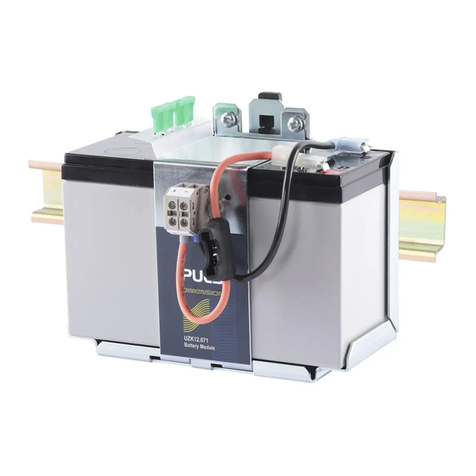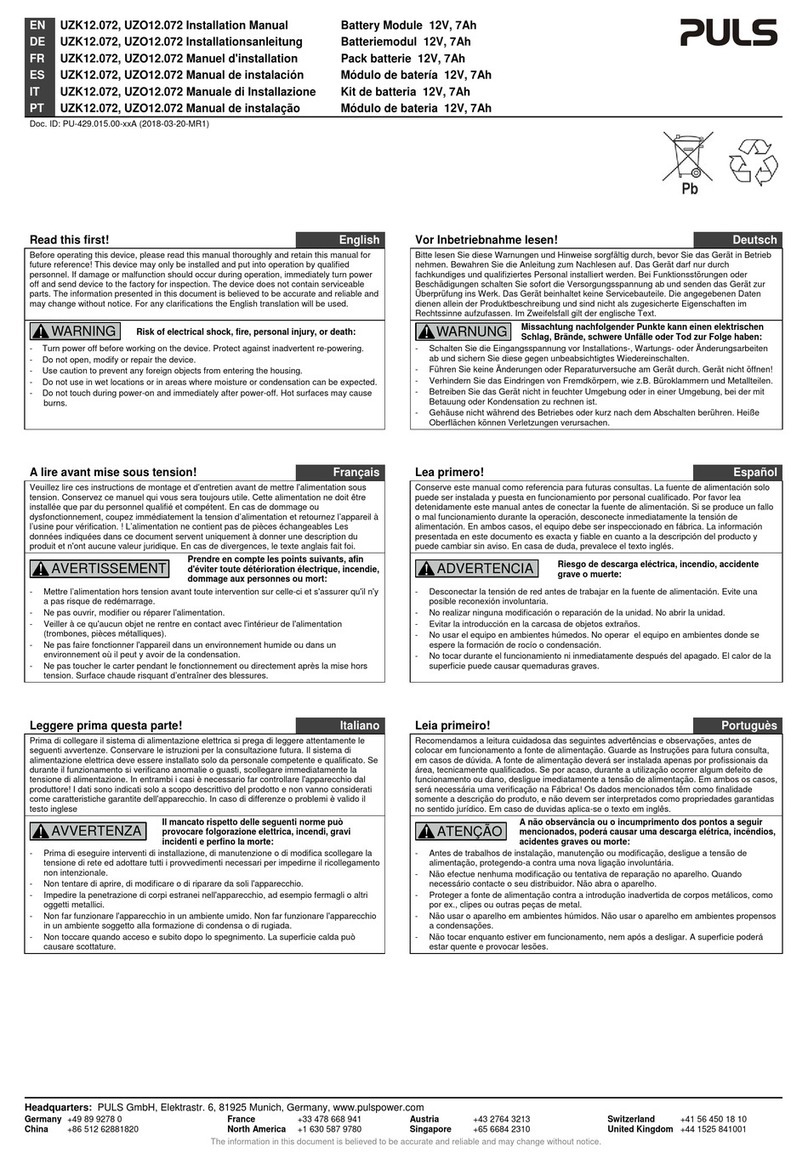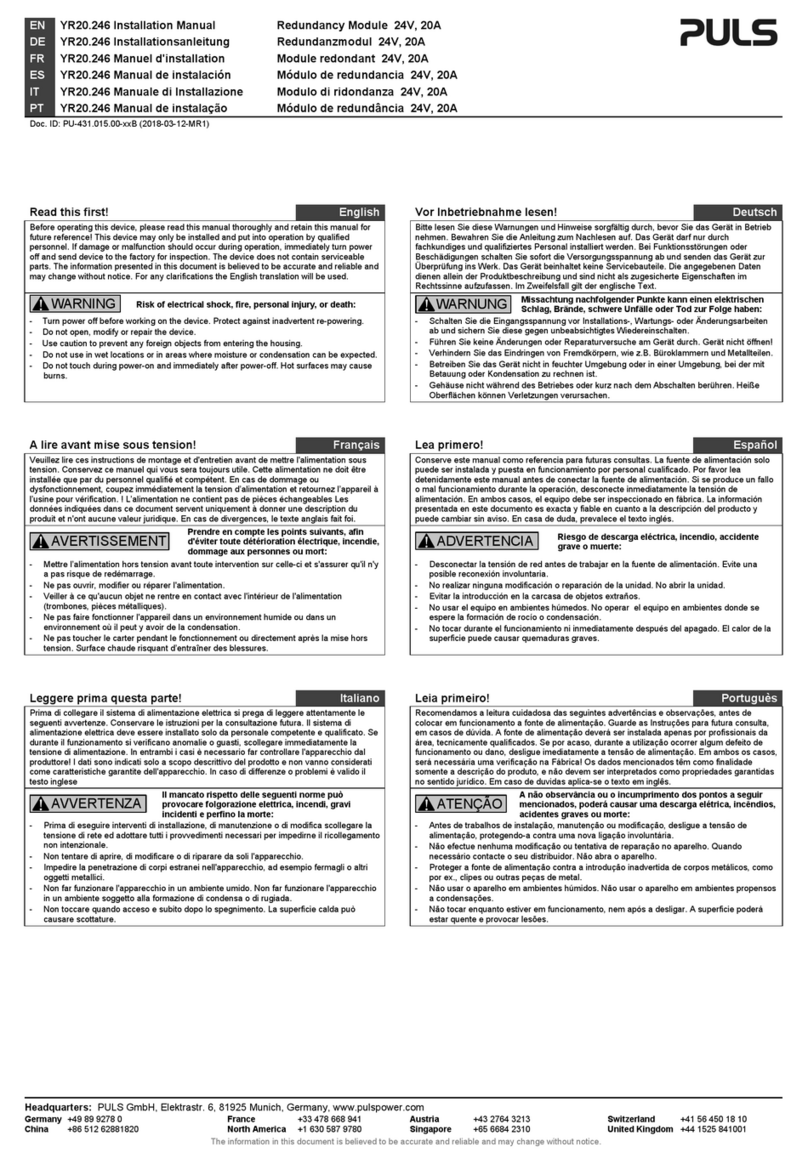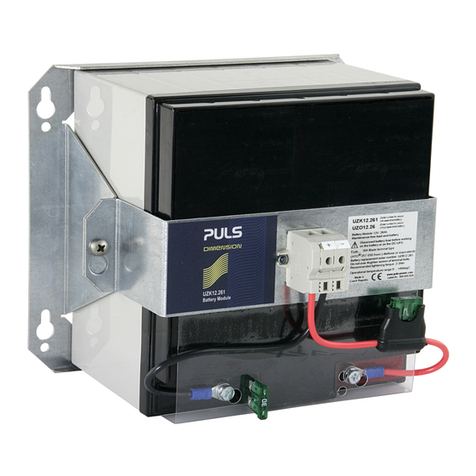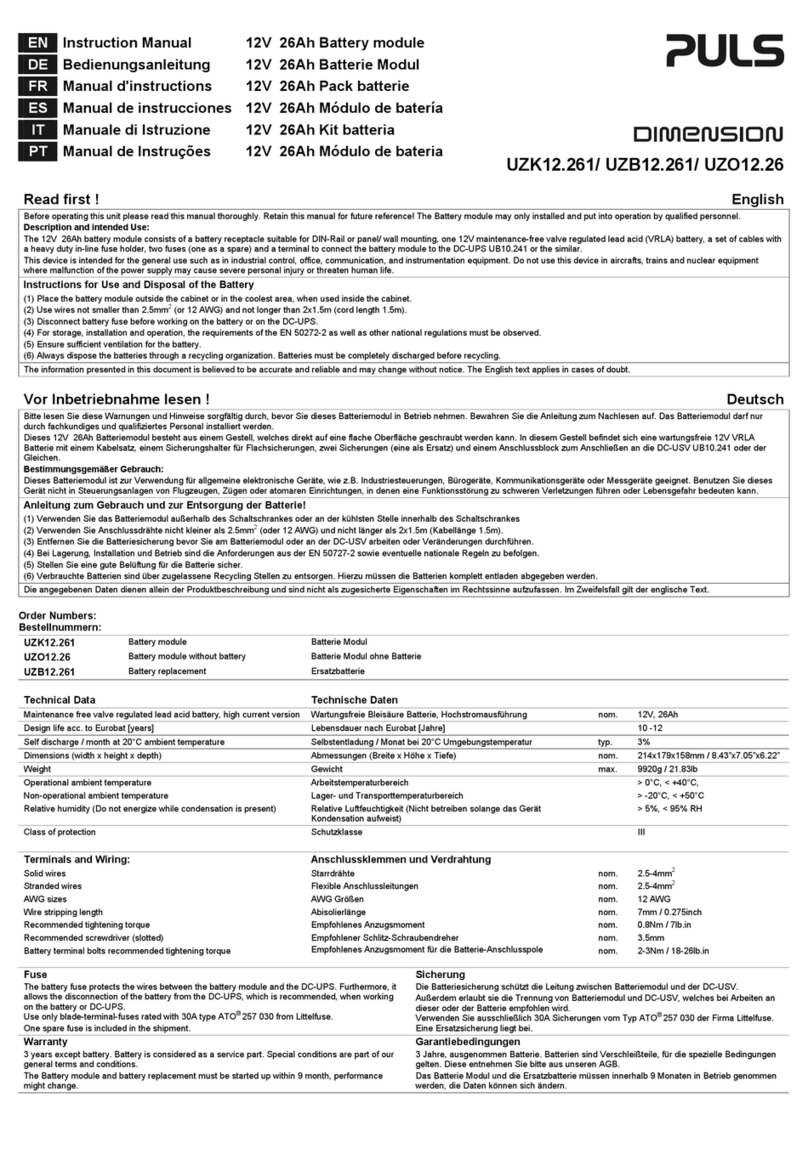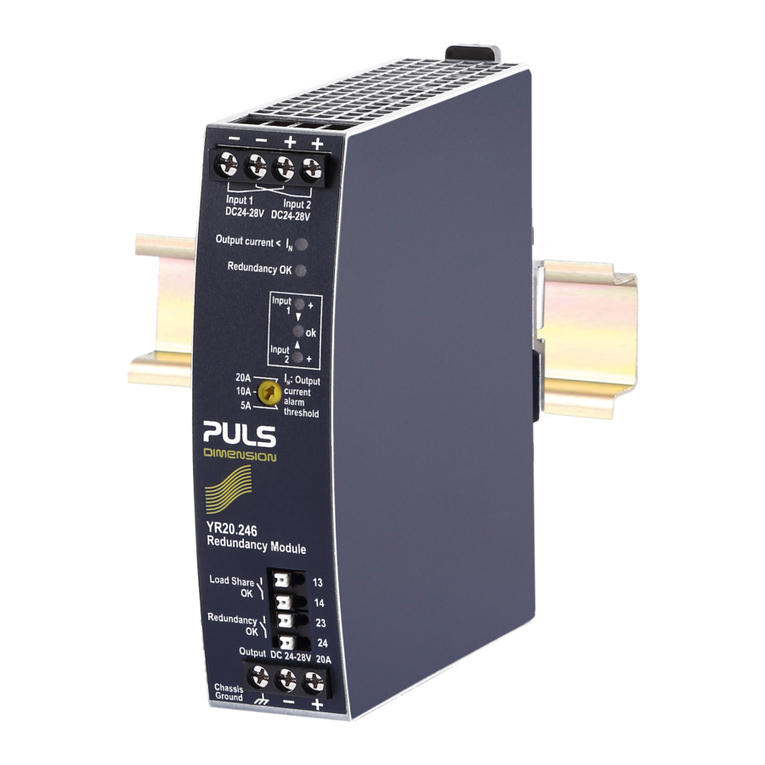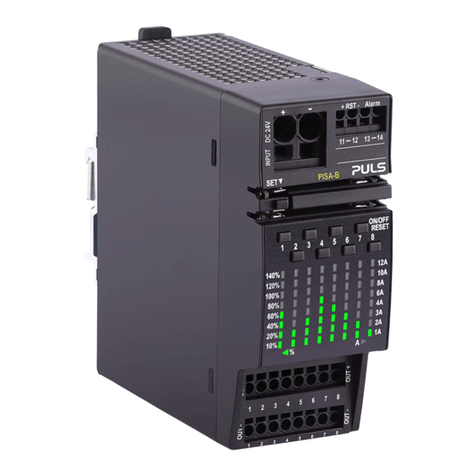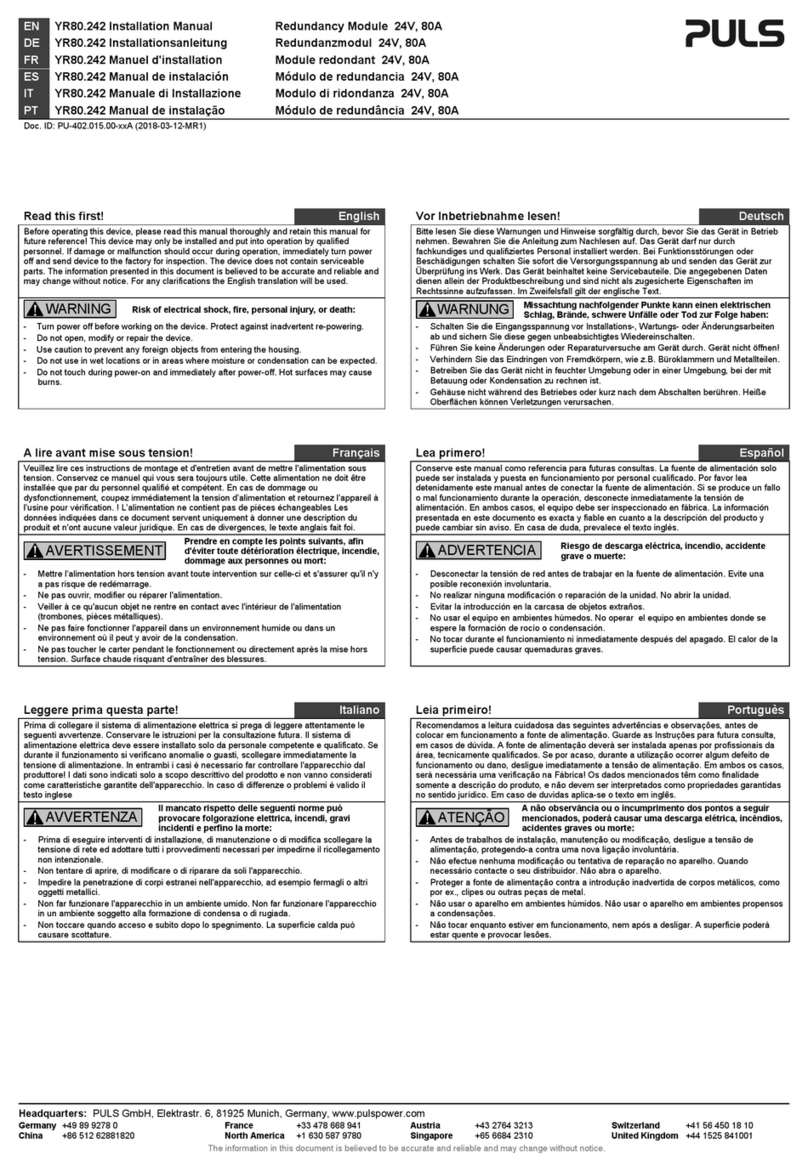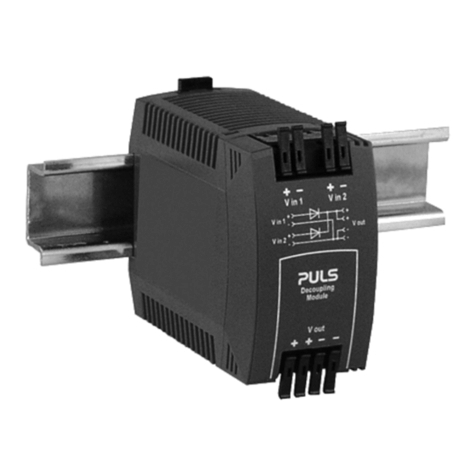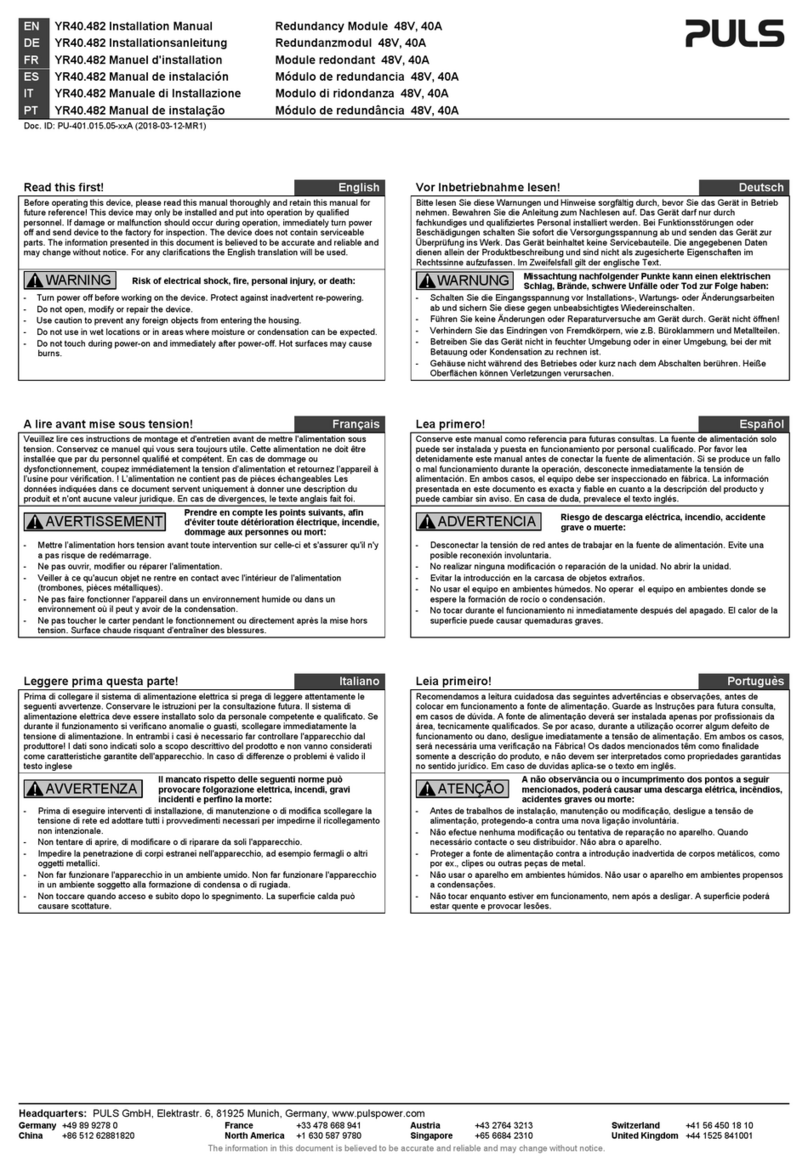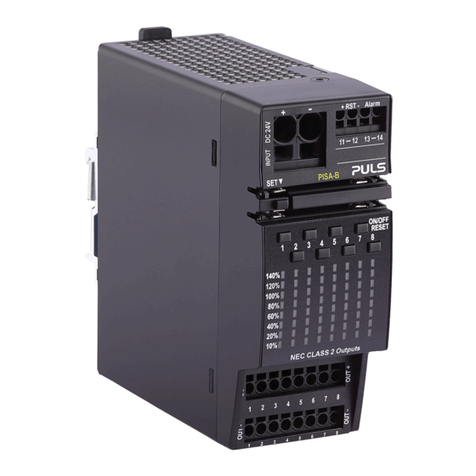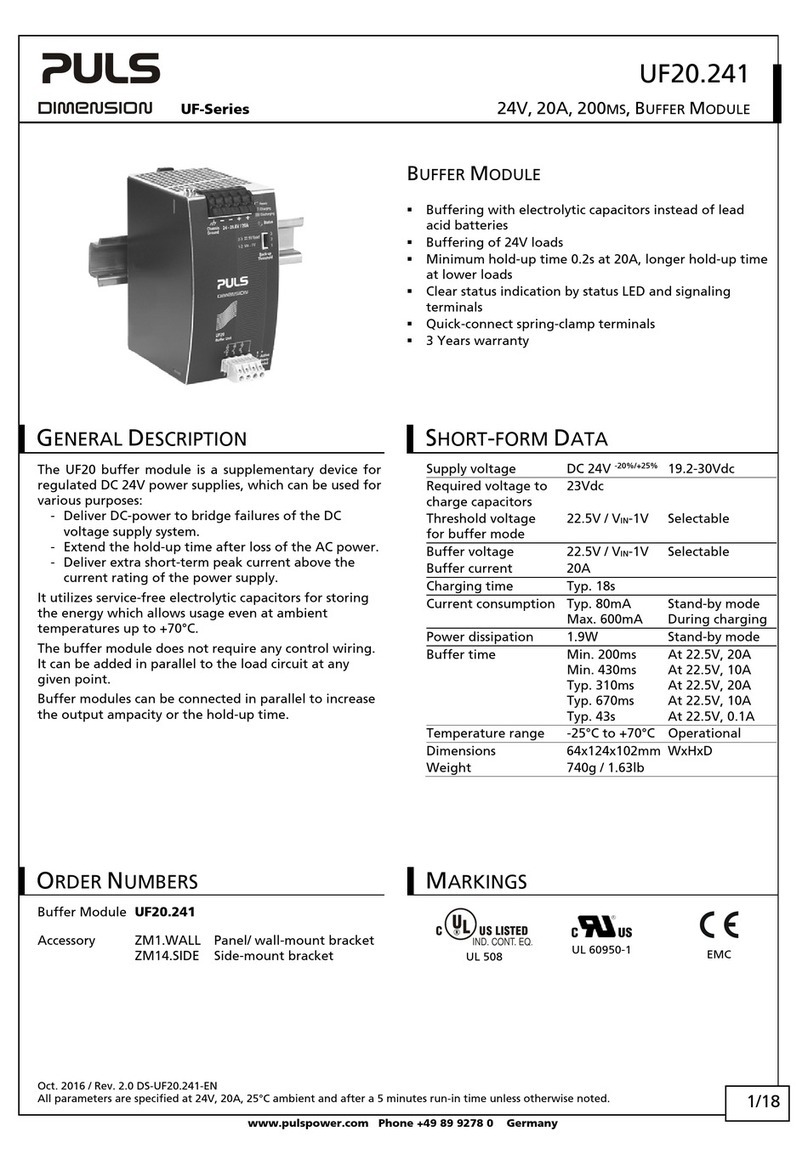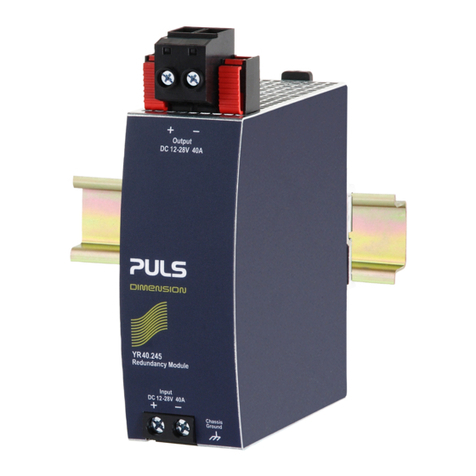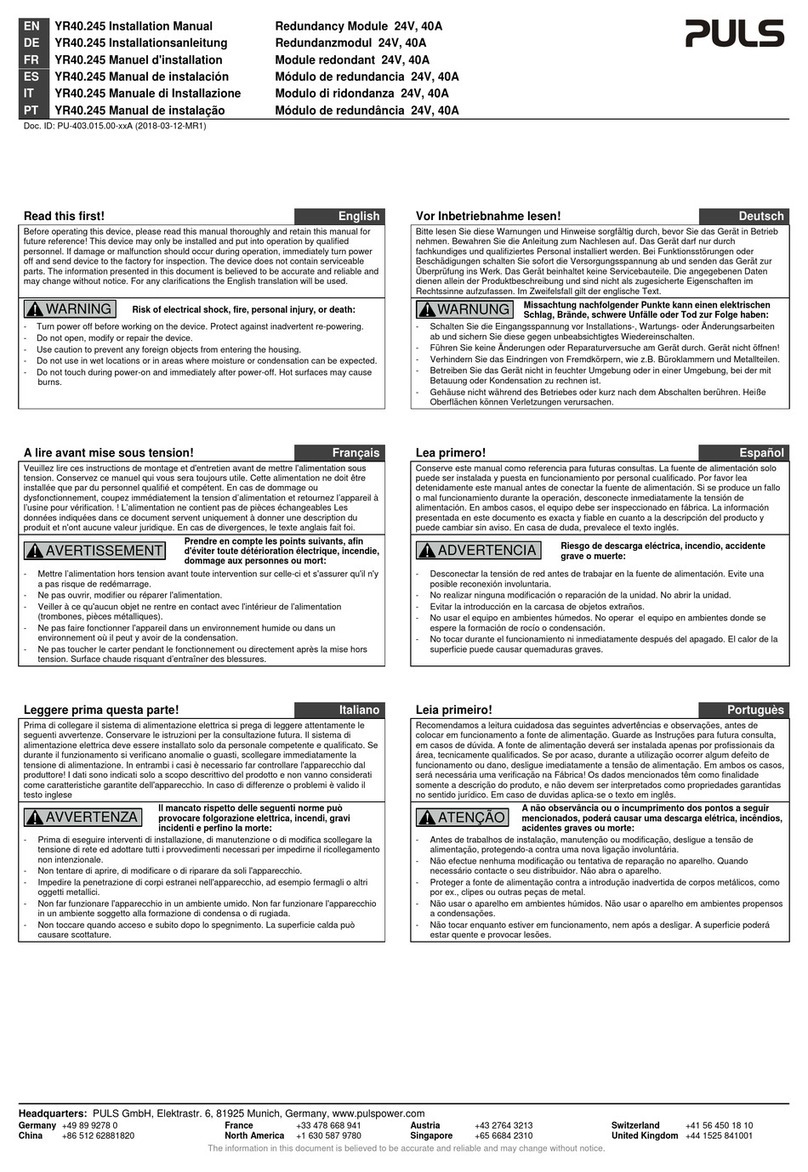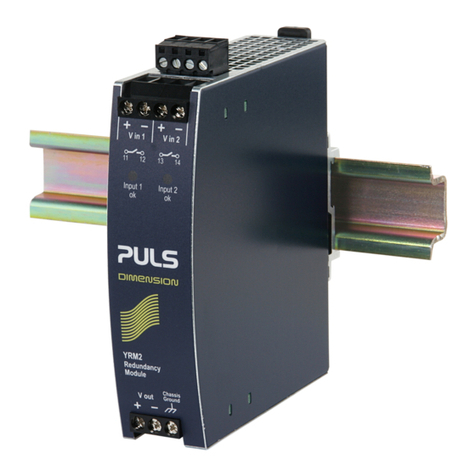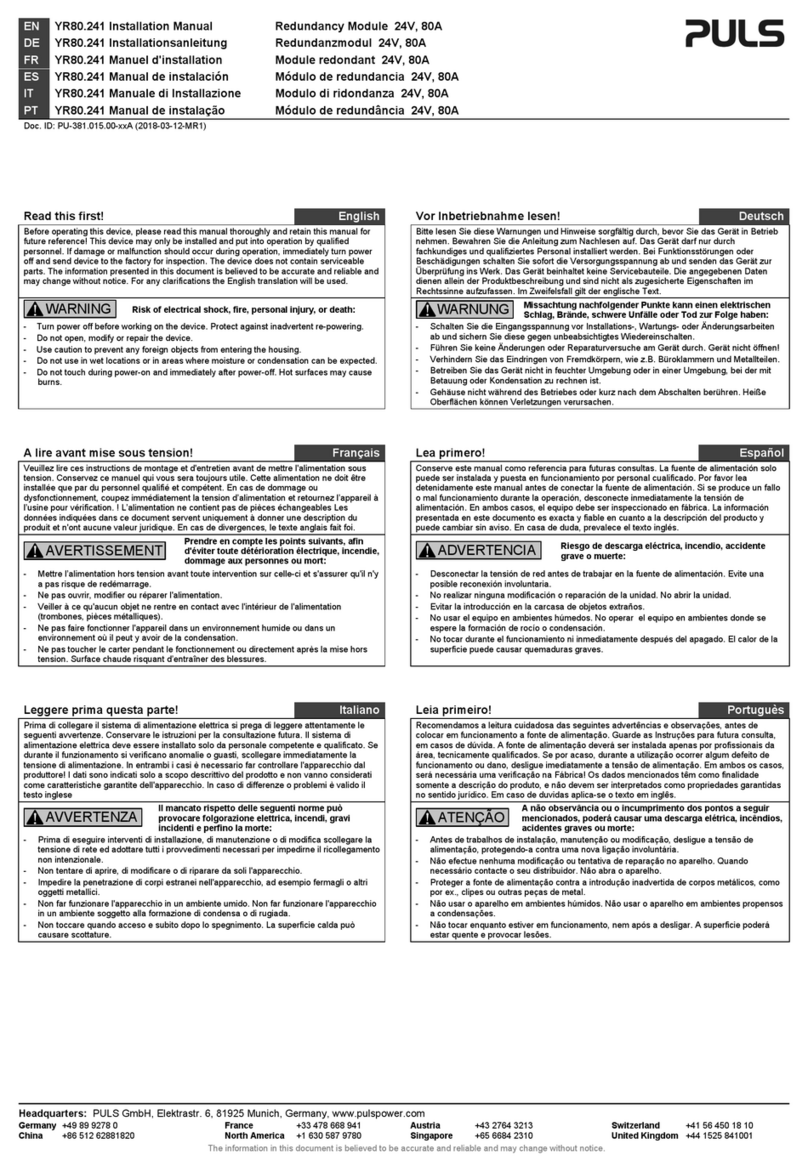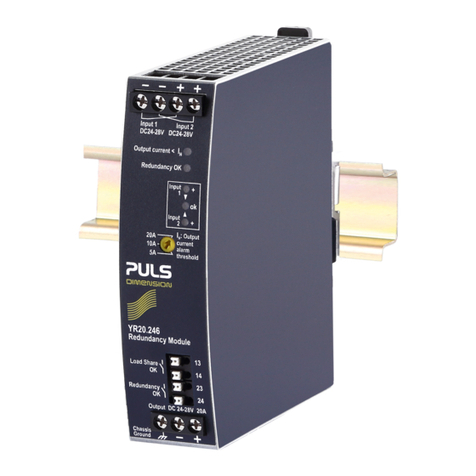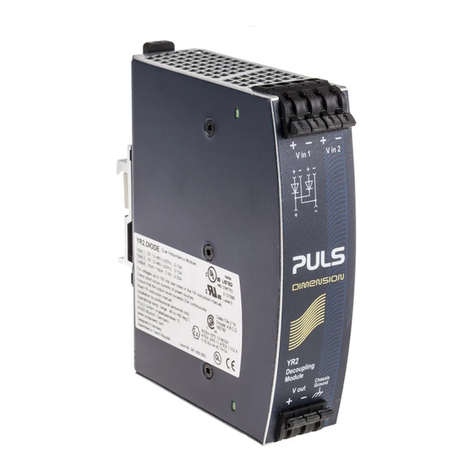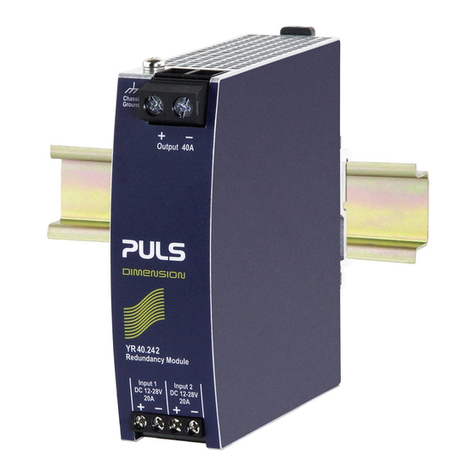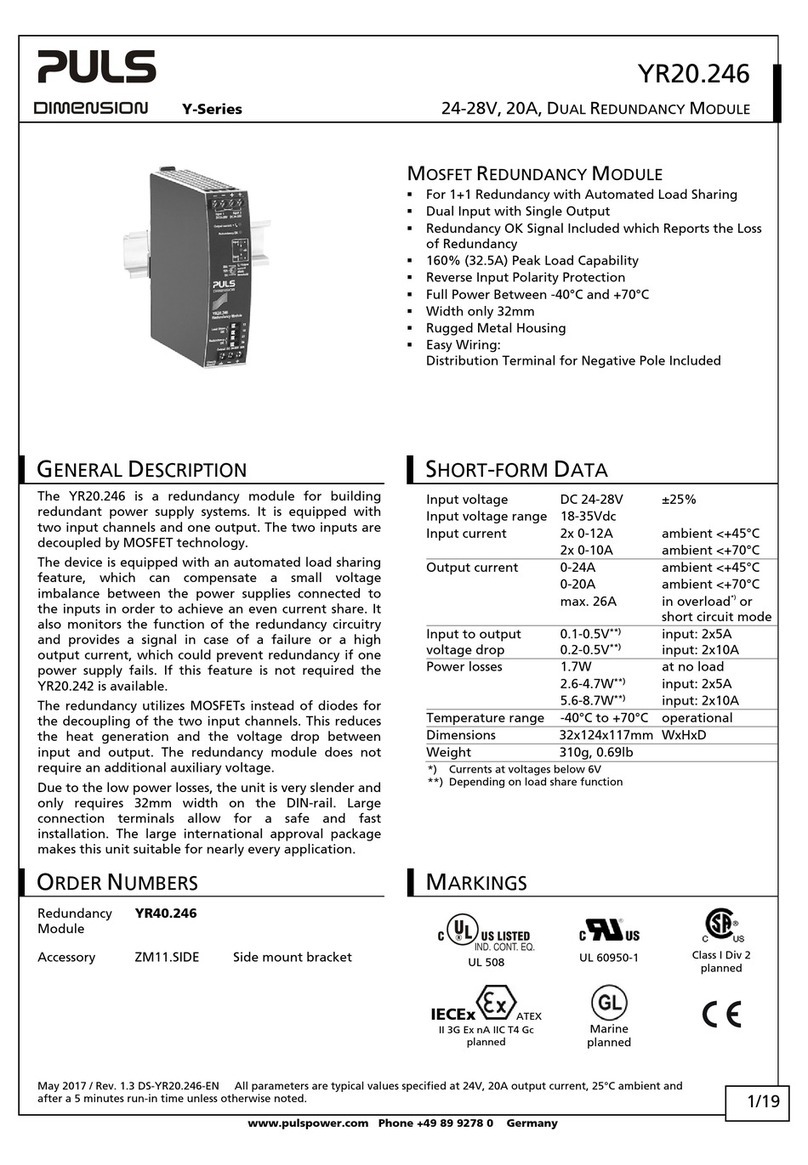MLY: Redundancy Modules Instruction Manual
MLY: Bedienungsanleitung für Redundanzmodule
Product Description
The reliability of the DC voltages can be increased by using redundant systems. To achieve
redundancy, one extra power supply must be installed in order to deliver the required current in
case one power supply in the system fails. Each individual power supply must be isolated from the
others with a redundancy module. These have decoupling diodes included and are equipped with
two input and one output channels. They can be used to build 1+1 and N+1 redundant systems.
Both units listed in this instruction sheet are electrically the same and differ only in the type of
terminals and the optical appearance. The MLY10.241 is a perfect fit for the ML15, ML30.241 and
ML60 power supplies, while the MLY02.100 is more suitable for the older MiniLine power supplies.
Gerätebeschreibung
Die Zuverlässigkeit von DC-Spannungen kann durch redundante Systeme erhöht werden. Um
eine Redundanz zu erreichen, muss ein zusätzliches Gerät in „Reserve“ installiert werden, das
dann den nötigen Laststrom zur Verfügung stellt, wenn ein Gerät im System ausfällt. Die
einzelnen Geräte müssen mit Redundanzmodulen entkoppelt sein. Diese beinhalten
Entkopplungsdioden und haben zwei Eingänge und einen Ausgang und können zum Aufbau von
N+1 oder 1+1 redundanten Systemen verwendet werden.
Die beiden hier aufgeführten Geräte sind elektrisch gleichwertig und unterscheiden sich nur in der
Klemmenart und in der optischen Ausführung. Das MLY10.241 ist den MiniLine Geräten ML15,
ML30.241 und ML60 angepasst, während das MLY02.100 für ältere MiniLine Geräte gedacht ist.
Technical Data 1) Technische Daten
1) MLY02.100 MLY10.241
Input Voltage Eingangsspannung nom. DC 12-48V
±25% DC 12-48V
±25%
Input Voltage Range Eingangsspannungsbereich - 9-60Vdc 9-60Vdc
Output Current 2) Normal Mode Ausgangsstrom
2) Normalbetrieb nom. 10A 10A
Overload, Short-circuit Überlast, Kurzschluss max. 16A 3) 16A 3)
Input Current 2) 1+1 Redundancy Mode Eingangsstrom
2) 1+1 Redundanz Modus nom. 2x 8A 2x 8A
N+1 Redundancy Mode N+1 Redundanz Modus nom. 2x 5A 2x 5A
Peak Input Current (per input) Eingangsspitzenstrom (pro Eingang) max. 125A for 10ms 125A for 10ms
Reverse Current 4) (per input) Rückwärtsstrom
4) (pro Eingang) max. 0.6mA 0.6mA
Decoupling Element Entkopplungselement - Diode Diode
Voltage Drop 5) (Input to Output) Spannungsabfall
5) (Eingang zu Ausgang) typ. 900mV 900mV
Power Losses 5) at full load Verlustleistung
5) bei Volllast typ. 9W 9W
at no load im Leerlauf typ. 0W 0W
Low-Input-Voltage Alarm Contacts Eingangsspannungsüberwachungsrelais - no / nein no / nein
Operational Temperature Range Betriebstemperaturbereich nom. -40°C - +70°C -40°C - +70°C
Output Derating Ausgangsstromrücknahme +60°C to +70°C 0.25A/°C 0.25A/°C
Storage Temperature Range Lagertemperaturbereich nom. -40°C - +85°C -40°C - +85°C
Humidity 6)Feuchte
6) IEC 60068-2-30 5 – 95% r.H. 5 – 95% r.H.
Vibration Schwingen IEC 60068-2-6 2g 2g
Shock Schocken IEC 60068-2-27 30g 6ms, 20g 11ms 30g 6ms, 20g 11ms
Degree of Pollution (non-conductive) Verschmutzungsgrad (nicht leitend) EN 50178 / IEC 62103 2 2
Degree of Protection Schutzart EN 60529 IP20 IP20
Class of Protection Schutzklasse IEC 61140 III III
Over-Temperature Protection Übertemperaturschutz OTP no / nein no / nein
Reverse Input Polarity Protection Eingangsverpolschutz - yes / ja yes / ja
Penetration Protection Fremdkörper Eindringschutz max. 2.5mm 2.5mm
Return Voltage Resistance 7) Rückspeisefestigkeit
7) max. 200Vdc 200Vdc
Isolation Against Housing Isolationsfestigkeit gegen Gehäuse min. 500Vac, 5MOhm 500Vac, 5MOhm
Quick-Connect Spring-Clamp Terminals Schnellanschluss Federkraftklemmen - yes / ja -
Screw Terminals Schraubklemmen - - yes / ja
Dimensions 8) (WxHxD) Abmessungen
8) (BxHxT) nom. 45x75x91mm 45x75x91mm
Weight Gewicht max. 140g, 0.31lb 140g, 0.31lb
Approvals Zulassungen -Æ9) Æ9)
Limited Warranty Gewährleistung Years / Jahre 3 3
1) All parameters are specified at 24Vdc input voltage, nominal output current, 25°C ambient
and after a 5 minutes run-in time unless otherwise noted.
2) 50% higher currents up to 5s are allowed. The average (RMS) current is not allowed to
exceed 103% of the nominal current if repetitive pulses occur.
1+1 and N+1 Redundancy modes are explained in figures 1 to 2.
3) Ensure that the continuous output current does not exceed this value. Check the short-circuit
current of power sources. Do not use power sources which can deliver higher currents.
4) Over the entire temperature range.
5) At nominal output current and symmetrical input currents. See figure 4.
6) Do not energize while condensation is present.
7) Loads such as decelerating motors and inductors can feed voltage back to the output of the
redundancy module. The figure represents the maximum allowed feed back voltage.
8) Depth without DIN-rail and connection terminals.
9) See datasheet or markings on the unit.
1) Alle Werte gelten bei 24Vdc Eingangsspannung, Nennausgangsstrom, 25°C Umgebungs-
temperatur und nach einer Aufwärmzeit von 5 Minuten, wenn nichts anderes angegeben ist.
2) 50% höhere Ströme sind bis zu 5s erlaubt. Der Mittelwert (RMS) des Stromes darf 103% des
Nennwertes nicht überschreiten, falls wiederholende Pulse auftreten.
1+1 und N+1 Redundanzmodus sind in den Bildern 1 bis 2 erklärt.
3) Der Dauerausgangsstrom darf auch im Fehlerfall diesen Wert nicht überschreiten. Verwenden
Sie keine Stromversorgungen, die in der Summe höhere Ströme liefern können.
4) Über den gesamten Arbeitstemperaturbereich.
5) Bei Nennausgangsstrom und symmetrischen Eingangsströmen. Siehe auch Bilder 4.
6) Nicht betreiben, solange das Gerät Kondensation aufweist.
7) Bremsende Motoren oder Induktivitäten können Spannung zum Ausgang des
Redundanzmoduls rückspeisen. Der Wert gibt die max. zulässige Rückspeisespannung an.
8) Tiefe ohne DIN-Schiene und Anschlussklemmen.
9) Siehe Datenblatt oder Prüfzeichen auf dem Gerät.
Installation
Use DIN-rails according to EN 60715 or EN 50022 with a height of 7.5 or 15mm. Mounting
orientation must be output terminals on bottom and input terminals on the top. For other
orientations see datasheet. Do not obstruct air flow as the unit is convection cooled. Ventilation
grid must be kept free of any obstructions. The following installation clearances must be kept
when power supplies are permanently fully loaded:
Left / right: 0mm (or 15mm in case the adjacent device is a heat source)
40mm on top, 20mm on the bottom of the unit.
Installation
Geeignet für DIN-Schienen entsprechend EN 60715 oder EN 50022 mit einer Höhe von 7,5 oder
15mm. Der Einbau hat so zu erfolgen, dass sich die Eingangsklemmen oben und die
Ausgangsklemmen unten befinden. Für andere Einbaulagen siehe Datenblatt. Luftzirkulation nicht
behindern! Das Gerät ist für Konvektionskühlung ausgelegt. Es ist für ungehinderte Luftzirkulation
zu sorgen. Folgende Einbauabstände sind bei dauerhafter Volllast einzuhalten:
Links / rechts: 0mm (oder 15mm bei benachbarten Wärmequellen)
Oben: 40mm, unten 20mm vom Gerät.
EMC Electromagnetic Compatibility
The devices are suitable for applications in industrial environment as well as in residential,
commercial and light industry environment without any restrictions. These devices comply with
FCC Part 15 rules.
CE mark is in conformance with EMC guideline 2004/108/EC as well as the low-voltage directive
(LVD) 2006/95/EC.
EMC Immunity: EN 61000-6-1, EN 61000-6-2
EMC Emission EN 61000-6-3, EN 61000-6-4, FCC Part 15 Class B
EMV Elektromagnetische Verträglichkeit
Diese Geräte erfüllen die Anforderungen für Anwendungen in industrieller Umgebung und für den
Wohn-, Geschäfts- und Gewerbebereich ohne Einschränkungen. Die Geräte erfüllen die
Anforderungen der FCC Teil 15.
Das CE Zeichen ist angebracht und erklärt die Erfüllung der EMV Richtlinie 2004/108/EG wie
auch der Niederspannungsrichtlinie 2006/95/EG.
Störfestigkeit: EN 61000-6-1, EN 61000-6-2
Störaussendung: EN 61000-6-3, EN 61000-6-4, FCC Part 15 Klasse B
